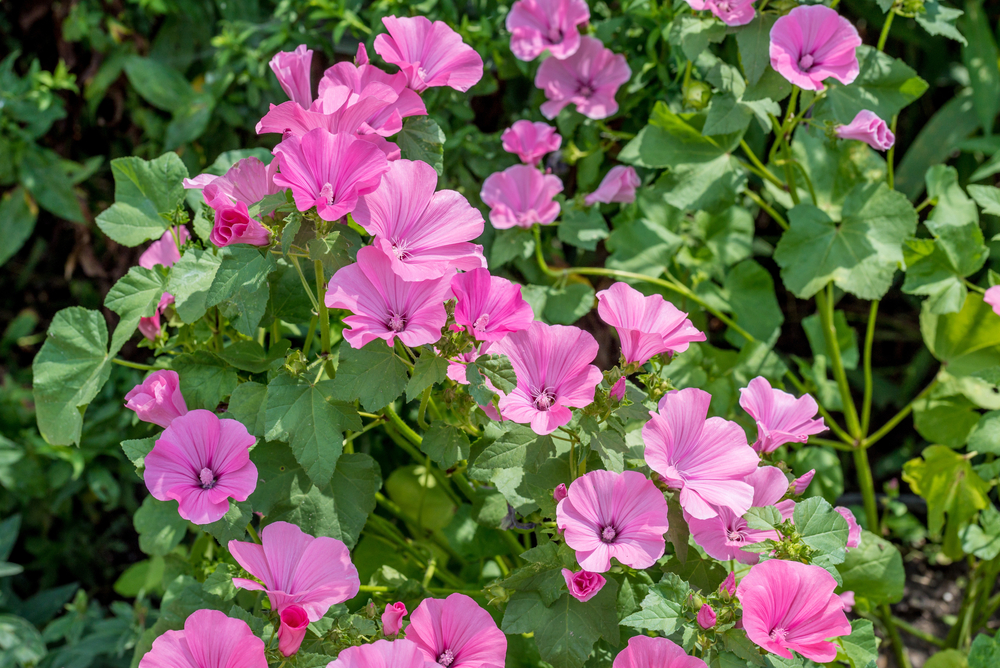The mallow flower is a lovely multi-colored flower that is traditionally used to cure many ailments. Mallows are easy to plant and nurture.
As you read this, you can learn the following:
* Mallow Flower Description
* How to Grow Mallow Flowers
* How to Care for Mallow Flower
* Varieties of Mallow Flowers
* Health Benefits of Mallow Flowers
Mallow Flower Description
Mallow is a part of the diverse family of malvaceae plants. Some other members of that family are cotton, hibiscus, and okra. The mallow plant can be used for ornamental and medicinal purposes.
The flower has fruits that are cheese-like in shape, and this earned it its nickname, cheese plant. The stem of a mallow plant comes from a central point and is flexible. A lot of people use this plant as medicine due to its diuretic, laxative, anti-inflammatory, and demulcent properties.
Mallow plants are a low growing weed that has a prostrate growth habit, and they are grown by planting the seed in summer or rooting a broken stem. The stems of the mallow plant come from its deep taproot.
The mallow flowers usually bloom in autumn, and they come out clustered in the leaf or singly. The flowers measure about 1 to 1.5 cm across and come in colors lilac, white and pink.
The leaves are 2-6 cm wide, alternate, and have long kidney-shaped petioles. They have short hairs on both the lower and upper surfaces of the leaves. Also, the short hairs are on the petioles and the margins.
Mallow plants can grow as high as 10 to 60 cm tall, making them an easily noticeable plant in a garden.
Mallow plants can grow on different types of habitat; it can grow on croplands, roadsides, lawns, waste areas, and gardens. The plant is a native of Northern Africa, Asia, and Europe. And as such, if you want to plant a mallow plant, you need an environment similar to its native regions if you want it to thrive.
How to Grow Mallow Flowers
If you want to grow mallow plants, you should sow them in early spring. For those planning to grow them as annuals, you should plant the seeds continuously from spring to early summer; this gives your garden a steady bloom of mallow flowers.
Once you sow the mallow seed, cover them with soil. Most mallows like to grow in an area where they are exposed to the sun. As such, you should position them in an area where they can get hours of sunlight and have a good water supply.
If you want to grow mallow plants indoors, and then transplant outside, here’s how to go about it:
* Plant the seeds in peat pots.
* The plant takes two weeks to germinate
* Leave it in the pots for about 8 weeks before transplanting in your garden
When planting them in your garden, ensure that you space small varieties at 30 t0 45 cm apart, while broad types should be placed 60 to 90 cm apart.
How to Care for Mallow Flowers
Mallow plants are easy to care for. Although they grow optimally in a sunny environment, they can still grow in partial shade. They can grow in all types of soil, provided they’re well-drained.
When a mallow plant reaches a height of 12 inches, you should pinch back the tip of any new growth forming at that height, this ensures that the plant is more compact.
Strong winds can affect the plant, as such, you should protect them from it by using a stake.
Once they’re fully matured, mallow plants thrive perfectly in nearly all environmental conditions. Although they can grow in drought, they thrive better in a well-watered area. Add a good fertilizer when you feel that the soil nutrient has depleted.
You should remove spent flowers to ensure that they grow new flowers. If you want to create a perfect condition for self-seeding, cut the plant back by a third after the first set of bloom has withered. Cut them further back to the basal foliage, when they start declining.
Varieties of Mallow Flower
Some varieties of mallow plant are;
Malva moschata: This variety has small flowers that are usually rose pink in color. It blooms continuously from early summer to middle fall. The leaves of this plant smell like musk, especially when you crush them.
Malva sylvestris: This is the most common type of mallow. Their flowers have colors purple and pink. They are captivating when in the right environment.
Malva sylvestris: They have an incredible display of colors, as their flowers are pink in color, and their flower veins are purple. The flowers are clustered around the lobed leaves of the plant, which stand beautiful on the shrubby stems. Some consume the malva sylvestris as food. The seeds are also added to salads, as it tastes like your hazelnuts.
Health Benefits of Mallow Flowers
The flower buds and leaves of most mallows contain vitamin C, tannins, mucus, essential oils, flavonoids, and tannins.
The flower of common mallow is the only known source of a naturally occurring chemical called glycoside malvin.
Another variety of mallows called malva sylvestris is traditionally used as a medicine to cure throat infection, bronchitis, asthma, coughing, and emphysema.
Mallows can be used to treat inflammation of the mucous membrane in the intestine, stomach, and mouth.
Herbalists use this herb to treat headaches, constipation, toothaches, kidney inflammation, kidney stones, gastritis, gallstones, and insomnia.
Due to the anti-inflammatory and anti-bacterial properties of common mallows, you can use it to treat eczema, insect bite, wounds, pimples, boil, swelling, boil, and acne.
Mallows are used by herbalists to treat numerous types of respiratory problems because they help to relieve pains in the mucosa of the respiratory tract. Mallows have substances that are present in the respiratory tract of the human being.
Don’t boil the plant if you want to use it for its medicinal properties.








